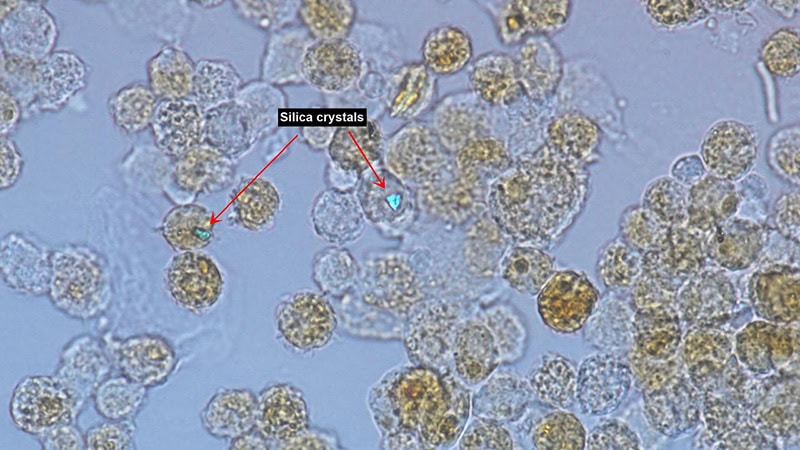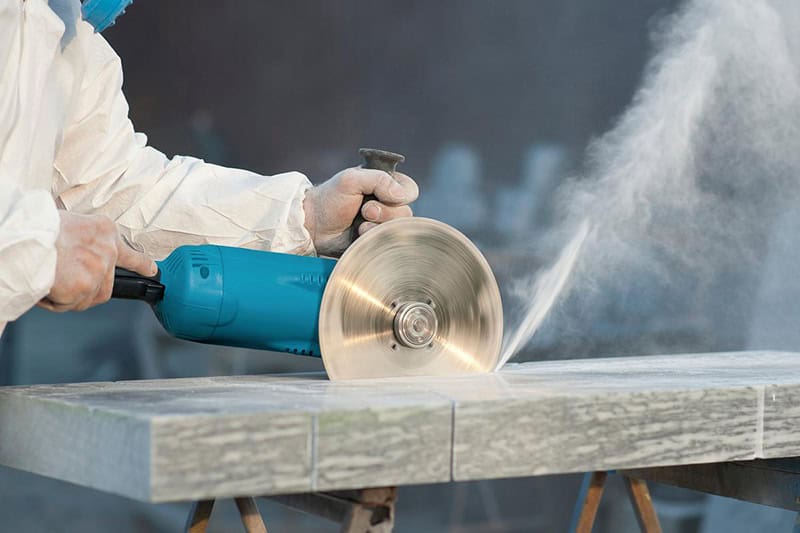Silicosis is a progressive and potentially fatal lung disease caused by prolonged exposure to respirable crystalline silica (RCS) particles. This debilitating condition primarily affects workers in industries where they encounter materials containing silica, such as artificial/engineered stone. In this blog post we will delve into what is silicosis, the dangers of silicosis, common sources of silica exposure and alternative products that can help reduce the risk of this debilitating disease.
What is Silicosis?
Silicosis is a chronic, irreversible lung disease caused by the inhalation of tiny silica dust particles. Silica, found in nature as quartz, is commonly used in various industrial processes and products. When workers breathe in these dust particles, they become trapped in the lunch causing inflammation and scarring. Over time, this can lead to severe breathing difficulties and in some cases, death.

Image above shows cells taken from the lungs of a patient with silicosis. Notice the speck of silica dust shining brightly.
The Dangers of Silicosis
Lung Damage
Silica dust particles irritate and scar the lung tissue, reducing its ability to function effectively. This leads to coughing, shortness of breath and reduced lung capacity making even simple tasks a challenge for those suffering from silicosis.
Increased Susceptibility to Other Diseases
Individuals with silicosis are more vulnerable to respiratory infections, tuberculosis & lung cancer. The disease also has the potential to develop into more severe forms such as progressive massive fibrosis (PMF).
Reduced Quality of Life
Living with silicosis can be debilitating. It significantly affects a persons quality of life, impacting their ability to work, participate in physical activities and enjoy daily life.
Video via Stop This Killer Stone
Common Sources of Exposure
Construction
One of the most common sources of silica exposure is within the construction industry due to workers frequent interaction with materials that may contain silica such as concrete, bricks and stone.
Recent protests outside Bunnings have brought to light another concerning source of silica exposure within the construction industry. These protests, reported in a news article from news.com.au, were linked to a “killer product.”
The “killer product” in question is often associated with engineered or artificial stone used in construction, such as quartz countertops. Engineered stone is favoured for its durability, versatility, and aesthetic appeal, but it can pose a significant health risk when not handled properly. The danger lies in the high concentration of crystalline silica within these materials. During the fabrication and installation of engineered stone products, workers often engage in tasks that generate airborne crystalline silica dust. Cutting, grinding, and polishing engineered stone without the appropriate protective measures can release fine silica particles into the air, putting workers at risk of inhaling this harmful dust.

Mining & Quarrying
Silica is naturally abundant in the earth, making miners and quarry workers susceptible to high levels of exposure
Manufacturing
Manufacturing processes that involve silica containing materials such as glass and ceramics can release fine dust particles
Agriculture
Workers who use products like diatomaceous earth ( a natural pesticide) can be exposed to silica.
Demolition
Demolition of structures often releases substantial amounts of silica dust.
Alternative Products & Practices
Substitute Materials Containing Silica
Look for alternatives that are silica-free or contain less silica. For example, consider using engineered stone without crystalline silica in place of traditional granite or marble.
Our Jonite stone range is a low silica product.
Dust Control Measures
Implement effective dust control measures such as dust extraction systems & PPE like respirators and goggles to reduce airborne silica dust during tasks.
Ventilation Systems
Install proper ventilation systems in workplaces to remove silica dust and maintain air quality
Education & Training
Properly educate & train workers about the dangers of silica exposure & preventative measures to take.
Regular Health Checks
Encourage regular health check-ups for workers to detect silicosis in its early stages.
Silicosis is a severe occupational disease that results from prolonged exposure to silica dust, primarily in industries like construction and mining. Understanding the dangers of silicosis and taking preventive measures is essential for safeguarding workers’ health. By exploring alternative products and practices that minimise silica exposure, we can reduce the risk of this debilitating lung disease and ensure a safer working environment for all.